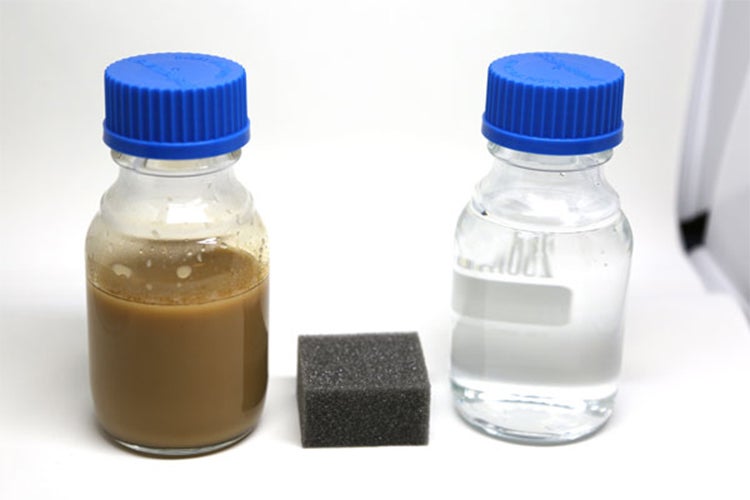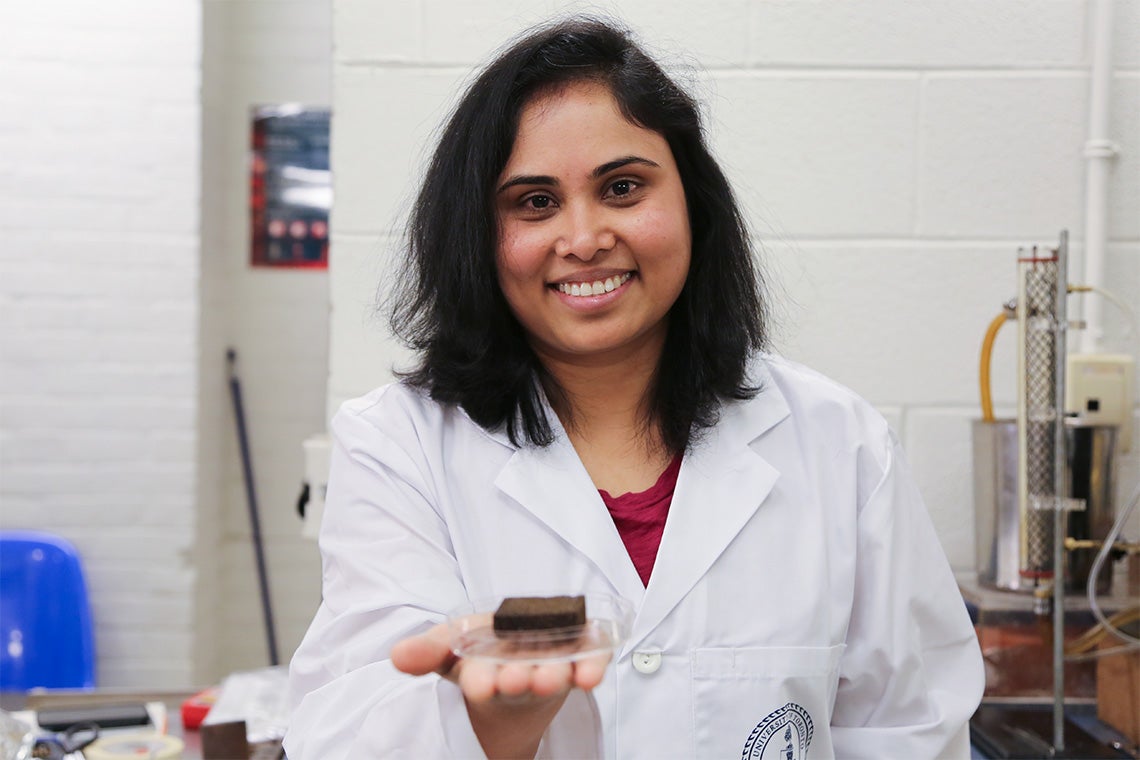U of T researchers develop sponge that removes oil from water
Published on by Water Network Research, Official research team of The Water Network in Technology
Designed to clean oil from industrial wastewater, U of T researchers are exploring whether sponge technology developed by PhD student, Pavani Cherukupally (pictured) can be adapted to help clean up marine and other spills (photo by Kevin Soobrian)
University of Toronto researchers have developed a new strategy to remove tiny oil droplets from wastewater with more than 90 per cent efficiency in just 10 minutes. Their secret weapon?
A sponge.
“Oil extraction operations such as hydraulic fracturing, or fracking, produce nearly 100 billion barrels of oil-contaminated wastewater each year,” says Chul Park , a professor in the department of mechanical and industrial engineering in the Faculty of Applied Science & Engineering.
“Because the oil is in the form of tiny droplets rather than a large oil slick, we can’t use the same strategies we would use to clean up a surface spill.”
Park’s graduate student, Pavani Cherukupally , took up the challenge. She drew on Park’s expertise in microcellular foams, as well as the water technology experience of her co-supervisor Assistant Professor Amy Bilton .
Cherukupally focused on the use of ordinary polyurethane foams – similar to those found in couch cushions – to separate tiny droplets of oil from wastewater. By carefully controlling the porosity and other properties, she designed sponges that would adsorb – or hold on its surface – oil droplets while letting water flow through efficiently. Two years ago, she reported a prototype that could remove more than 95 per cent of the oil in the samples she tested.

U of T researchers have developed a chemically modified sponge that can remove emulsified microdroplets of oil from wastewater with more than 90 per cent efficiency in just 10 minutes (photo by Kevin Soobrian)
But there were two major drawbacks to this system. The first was a slow rate of removal. It took three hours to remove oil droplets from water, which would not be fast enough for an industrial-scale process.
The other had to do with the pH of the water.
“The optimal pH for our system was 5.6, but real-life wastewater can range in pH from around four to 10,” says Cherukupally. “As we got toward the top of that scale, we saw removal drop off significantly, down to maybe six or seven per cent.”
In her latest work, published today in the journal Nature Sustainability , Cherukupally partnered with U of T chemists Wei Sun and Annabelle Wong in the lab of Geoffrey Ozin , a professor in the department of chemistry in the Faculty of Arts & Science, to chemically modify the foams. By adding tiny particles of a material known as nanocrystalline silicon to the foam’s surface, they were able to control its critical surface energy.
Abstract
In the United States, the oil industry produces over 15 billion barrels of wastewater contaminated with crude oil microdroplets annually. Current methods are ineffective for the removal of these microdroplets at the variable pH conditions commonly found in wastewater. Here, an innovative surface-engineered sponge (SEnS) that synergistically combines surface chemistry, charge and roughness, provides a solution to this problem. Over broad pH conditions, the SEnS rapidly adsorbed oil microdroplets with 95–99% removal efficiency, predominantly facilitated by Lifshitz–van der Waals forces. At the optimum pH, 92% of the oil was adsorbed within 10 min. The oil was subsequently recovered by solvent extraction under ambient conditions, and the cleaned SEnS was reused for oil microdroplets adsorption ten times. The combined efficacy and reusability can enable large-scale removal and recovery of crude oil microdroplets from wastewater.
Media
Taxonomy
- Oil Spill Treatments
- Spill Containment
1 Comment
-
GLAD TO KNOW, FEEL FREE TO REACH OUT SHOULD YOU NEED FURTHER HANDS IN MARKETING YOUR PRODUCT TOO.
Fantastic development, yes, the oil and Gas industry is in need for ways of stopping wastewater contamination. Indeed, most specifically oil and Gas industry are facing challenges world over, most specifically in Nigeria in West Africa. This innovative surface-engineered sponge (SEnS) that synergistically combines surface chemistry could assist the industry tremendously.
